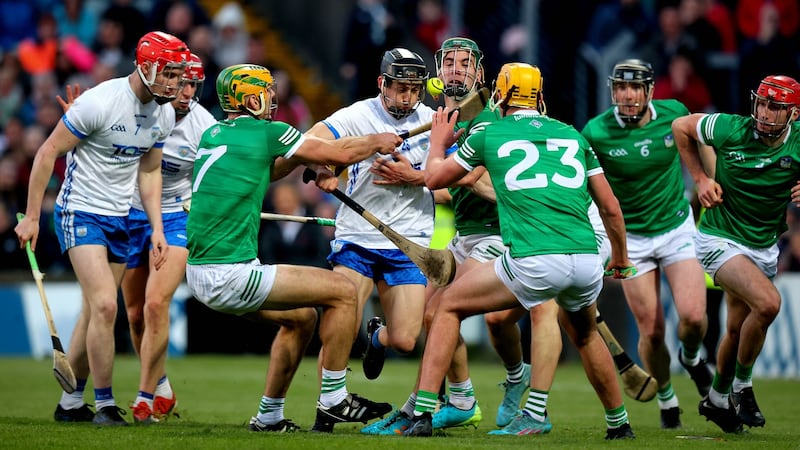In a curious and largely unremarked-on coincidence, the weekend’s hurling championship matches involved re-runs of the last three league deciders. It was an interesting counterpoint to the growing speculation as to where the competition slots into preparations for any team with serious summer aspirations.
Of course it’s particularly random given that 2020 and 2021 were not conventional league campaigns and decided by improvised criteria that saw Galway and Kilkenny share the title in 2021, as the teams that had finished top of Divisions 1A and 1B.
There was provision for a play-off should the counties meet subsequently in the championship but thanks to Dublin’s eviction of Galway, that never came to pass.
It did however the previous year when the corresponding counties, Limerick and Clare met in a Munster quarter-final in Thurles to decide not just who would proceed to the provincial semi-final against Tipperary but also who would win the 2020 league, which Limerick did without undue fuss.
It was last year’s league that crystallised doubts about the competition’s role in getting ready for championship.
Waterford clearly finished the campaign in April as the team of the season until that point, having annihilated the previously undefeated Wexford and then beaten Cork to underline their status as a consistent rival to Limerick.

Where that took Liam Cahill’s team is a matter of historical record: an unconvincing championship win over a Tipperary team that would finish the round robin with no points followed by a narrow defeat by Limerick, which was widely misread as proving the team’s credentials as the champions’ closest challengers.
It wasn’t an unreasonable interpretation of a three-point loss in the Gaelic Grounds but everything went downhill from that point and the late goals that narrowed the deficit and the ease with which Limerick absorbed the shock and pulled away became more significant in retrospect.
Liam Cahill, who had led Waterford to an All-Ireland final and semi-final and a league title – remember the county have just four of those in the competition’s 98-year history – duly became the county’s third manager to move on in three round-robin championships.
That’s the issue for Limerick at the moment. Having convincingly won the league for the third time in five years in the context of dominating the championship during the same period, few thought that John Kiely’s team would end up exhibiting some of the same symptoms of malaise as Waterford last year.
Yet that is how it has played out. Yes, it’s important to note that the round robin is just two weeks old and more open than ever at this stage, with four teams locked together on two points and everything to play for.
Limerick are just coming off a weekend when they lost a cracking championship match by one point – to a team that has bothered them more consistently than anyone in the past two seasons – but who would have forecast after the league final demolition of Kilkenny that the champions would be one from two with a scoring difference of just plus-one?
They themselves appeared rattled after the closeness of the Waterford match. Manager Kiely, whose steely intelligence has kept this cohort between the tramlines since they were under-age players, was surely deflecting when he lambasted punditry and media for the fact that a team with four All-Irelands in five years were unbackable favourites.
They have also sustained injuries to two of the team’s brightest stars, Seán Finn and Cian Lynch, the extent of which have yet to emerge. The most positive aspect for Limerick is the three-week break until their next match.
On the substantive point of whether winning the league is a handicap when it comes to championship, precedent is varied. There have been eight doubles this century but for much of that time it could be argued that conditions were optimal.
The calendar year with league leading into championship, gave regular fixtures but with a decent break in between and before the days of the round robin, we saw seven teams win both league and championship in 17 years – the eighth was Limerick in 2020, which as referenced above was a one-off format.
It’s worth noting that five of those seven years saw Kilkenny achieve the feat so maybe it was a consequence of that county’s domination (still farther reaching than Limerick’s is currently), and generally untroubled provincial commitments.
[ The Schemozzle: Conlon family enjoy a day to rememberOpens in new window ]
[ Nicky English: Clare raise the stakes as questions about the champions intensifyOpens in new window ]
Whatever about that, Galway (2017) and Tipperary (2001) were quite happy to build momentum on the way to milestone All-Irelands but as a trend, no county apart from Kilkenny made it a feature of successful championship years.
Have we now reached a point at which the league has almost become a counter-indicator for teams?
That was the evidence of the 1990s until – significantly? – the calendar year kicked in, from 1997. Eight successive league winners did sufficiently poorly in the ensuing championship that their managers stepped down at the end of the season.
And still, optimism thrives. After the 1973 league final, Paddy Downey wrote in these pages: “Many among the 20,814 spectators who witnessed the National hurling league final between Wexford and Limerick at Croke Park yesterday left the ground at the end of a great game with a distinct impression that they had had a preview of the 1973 All-Ireland champions.”
They had but not the ones they thought.
The last two years have shown the strength of the perception left by league victories. Waterford crashed and burned. Limerick remain alive in this year’s All-Ireland but to date it hasn’t been the procession expected after the league final.

The champions have been here previously. Four years ago Limerick followed up on the current team’s first All-Ireland by sweeping to the 2019 league and establishing themselves as front runners to win back-to-back Liam MacCarthy Cups.
Coming into the championship in the second round, having been the idle team in round one, theoretically giving them time to recover from the league, they faced in the Gaelic Grounds a Cork side well beaten at home by Tipperary the first day out.
Limerick were comprehensively and surprisingly defeated, prompting the usual gloomy reflection on the value of the spring competition.
When they lost again in the final round-robin match to Tipperary, it was more a reflection of their tactical calculations – resting players as their progress was assured – although it did cause hand wringing about the appropriateness of losing two matches and still being in the championship.
This was all however swept from the public consciousness after their blitzkrieg dismissal of Tipp in the Munster final, but they ended the year getting clipped by Kilkenny in an All-Ireland semi-final. Had the cracks in their season been evident from an early stage, after all?
Declining performance levels are always a concern. Teams will be wondering whether in the new split calendar the expenditure of impressive displays puts league winners into some sort of performance debt – however long it takes to discharge.
















